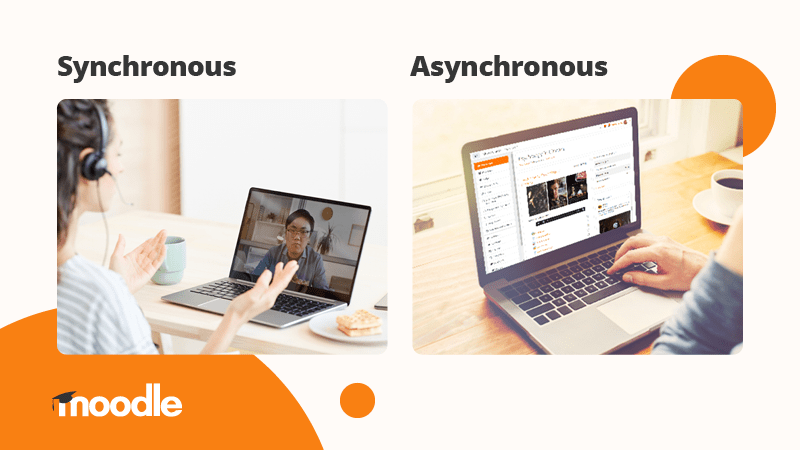There has been much debate in recent years on whether educators, trainers or L&D managers should focus on delivering synchronous or asynchronous online learning experiences.
What is the difference between synchronous and asynchronous learning?
In the context of online education, synchronous learning experiences are those delivered live with an educator or trainer facilitating a learning session. There are a variety of tools that can be used in synchronous learning such as live meetings or virtual classrooms where educators and learners meet virtually in real-time (by means of a device over a network) and communicate and collaborate through video, chat, whiteboard and other synchronous tools. In contrast, while also requiring a device, asynchronous learning is a student-centred method usually delivered via a learning management system (LMS) that allows learning to occur in different times and spaces particular to each learner. In asynchronous learning, educators set up a learning program or course that students engage with at their own pace.
Social constructionism – learning as a social context
As many readers will be aware, Moodle is based on social constructionism, which is the understanding that people develop knowledge in a social context. Moodle advocates for, and supports, the importance of creating a collaborative community of learners where learners learn “by doing” and by observing their peers. A community where educators and trainers understand the context of learners so that they can customise the language and expression of concepts in ways that are best suited to the audience. And, where teachers or trainers recognise themselves as learners and are willing to collaborate, listen and share ideas in order to improve their own understanding and ultimately inform improvements to the learning program.
So, synchronous is better, right? Wrong.
This grounding in social constructionism could lead readers of this blog to think that Moodle would advocate for synchronous over asynchronous delivery. But to presume so would be wrong because asynchronous delivery also supports the theory of social constructionism. In order to create truly engaging learning experiences, it is equally important that asynchronous activities provide opportunities for learners to learn by doing and through relationships with each other and their teachers.
This does not mean that asynchronous instruction should replace the opportunity for educators, trainers and their learners to meet in real-time through virtual classrooms with live video and messaging functionality. Indeed, this modality of online synchronous delivery mirrors good traditional classroom instruction where a teacher or instructor supports students to become actively involved in their learning through interaction with each other and their teacher as they complete tasks or activities.
Together is better
The issue is not whether asynchronous or synchronous delivery is better, but how both can be used to support the theory of social constructionism, accommodate different learning preferences and ultimately the engagement of learners through interaction with each other and their teacher.
Some face to face interaction is an essential component of good quality online instruction. That is why BigBlueButton, the open source web conferencing solution providing real-time sharing of audio, video, slides, whiteboard, chat and screen, will be incorporated into Moodle 4.0 as a standard feature. Currently available as a Moodle plugin, BigBlueButton, allows educators trainers to use breakout rooms, polls, multi-user whiteboard, and shared notes to engage learners in real-time. However, it is worth recognising that streaming video and connecting to online meetings use a lot of data and require fast internet connections, which not all learners may have at the same time. Even where connectivity is not an issue, technical issues can affect the quality of live interaction. These issues can be mitigated by using a combination of synchronous and asynchronous delivery methods.
More importantly, learners differ in the way that they perceive and comprehend information that is presented to them. For instance, some learners will understand content more quickly through visual or auditory means rather than printed text. Other learners with sensory disabilities or learning difficulties will have specific needs. To accommodate all learners’ preferences, it is important that educators create asynchronous Activities and Resources in a variety of modalities that learners can interact and engage with.
Online collaboration and group work can also be done well asynchronously. As an example, educators and trainers can use Moodle’s many standard features to encourage learner interaction and experimentation. For instance, they can invite personal response through Moodle Forum, create learner Groups, set Assignments, encourage collaboration through peer assessment with Workshops and allow students to create collaborative project plans and documents through Wiki. Asynchronous courses also accommodate more introverted students who may struggle to interact with other learners and their teacher or instructor in a live setting.
Both synchronous and asynchronous delivery has benefits for educators, trainers and learners:
Moodle was designed for ultimate flexibility, a toolbox that accommodates both synchronous and asynchronous delivery to empower educators and trainers to build their own education platform that is appropriate to their learners.
Find out more about our online learning platforms Moodle LMS or Moodle Workplace. Or, contact a Moodle Certified Service Provider who can help you with learning design, custom development, hosting, onboarding, installation and integrations.
References:
https://elearningindustry.com/blending-asynchronous-and-synchronous-digital-learning-modalities-part-5
https://www.brynmawr.edu/blendedlearning/asynchronous-vs-synchronous-learning-quick-overview
https://elearningindustry.com/right-learning-modalities-asynchronous-and-synchronous-interactions
https://elearningindustry.com/asynchronous-and-synchronous-modalities-deliver-digital-learning
https://educationrickshaw.com/2020/03/30/the-unproductive-debate-of-synchronous-vs-asynchronous-learning/





